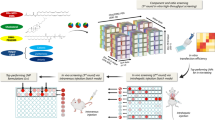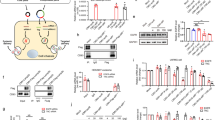ABSTRACT
Purpose
Regulation of gene expression using small interfering RNA (siRNA) is a promising strategy for treatments of numerous diseases. However, the progress towards broad application of siRNA requires the development of safe and effective vectors that target to specific cells. In this study, we developed a novel recombinant high density lipoprotein (rHDL) vector with high siRNA encapsulation efficiency.
Methods
They were prepared by condensing siRNA with various commercial cationic polymers and coating the polyplex with a layer of lipids and apolipoprotein AI (apo AI). The rHDL nanoparticles were used to transfect SMMC-7721 hepatoma cells with stable luciferase expression. The uptake and intracellular trafficing of siRNA were also investigated.
Results
Characterization studies revealed these rHDL nanoparticles had similar physical properties as natural HDLs. The various rHDL formulations had high silencing efficiency (more than 70% knockdown) in hepatocytes with minimum cytotoxicity. Moreover, the uptake of rHDL by SMMC-7721 was confirmed to be mediated through the natural HDL uptake pathway.
Conclusions
The work described here demonstrated the optimized rHDL nanoparticles may offer a promising tool for siRNA delivery to the liver.









Similar content being viewed by others
Abbreviations
- apo A-I:
-
apolipoprotein A-I
- PEI:
-
polyethyleneimine
- PLL:
-
poly-L-lysine
- RES system:
-
reticuloendothelial system
- rHDL:
-
recombinant high density lipoprotein
REFERENCES
Hannonand GJ, Rossi JJ. Unlocking the potential of the human genome with RNA interference. Nature. 2004;431:371–8.
Kimand DH, Rossi JJ. Strategies for silencing human disease using RNA interference. Nat Rev Genet. 2007;8:173–84.
de Fougerolles A, Vornlocher HP, Maraganore J, Lieberman J. Interfering with disease: a progress report on siRNA-based therapeutics. Nat Rev Drug Discov. 2007;6:443–53.
Chiu Y-L, Ali A, Chu C-Y, Cao H, Rana TM. Visualizing a Correlation between siRNA Localization, Cellular Uptake, and RNAi in Living Cells. Chem Biol. 2004;11:1165–75.
Guo JF, Bourre L, Soden DM, O’Sullivan GC, O’Driscoll C. Can non-viral technologies knockdown the barriers to siRNA delivery and achieve the next generation of cancer therapeutics? Biotechnol Adv. 2011;29:402–17.
Semple SC, Akinc A, Chen JX, Sandhu AP, Mui BL, Cho CK, et al. Rational design of cationic lipids for siRNA delivery. Nat Biotechnol. 2010;28:172–6.
Kapoorand M, Burgess DJ. Efficient and safe delivery of siRNA using anionic lipids: Formulation optimization studies. Int J Pharm. 2012;432:80–90.
Kim N, Jiang DH, Jacobi AM, Lennox KA, Rose SD, Behlke MA, et al. Synthesis and characterization of mannosylated pegylated polyethylenimine as a carrier for siRNA. Int J Pharm. 2012;427:123–33.
Christie RJ, Matsumoto Y, Miyata K, Nomoto T, Fukushima S, Osada K, et al. Targeted polymeric micelles for siRNA treatment of experimental cancer by intravenous injection. Acs Nano. 2012;6:5174–89.
Kundu AK, Chandra PK, Hazari S, Ledet G, Pramar YV, Dash S, et al. Stability of lyophilized siRNA nanosome formulations. Int J Pharm. 2012;423:525–34.
Kim SI, Shin D, Choi TH, Lee JC, Cheon GJ, Kim KY, et al. Systemic and specific delivery of small interfering RNAs to the liver mediated by apolipoprotein A-I. Mol Ther J Am Soc Gene Ther. 2007;15:1145–52.
Lee H, Kim SI, Shin D, Yoon Y, Choi TH, Cheon GJ, et al. Hepatic siRNA delivery using recombinant human apolipoprotein A-I in mice. Biochem Biophys Res Commun. 2009;378:192–6.
Yang M, Jin HL, Chen JA, Ding LL, Ng KK, Lin QY, et al. Efficient cytosolic delivery of siRNA using HDL-mimicking nanoparticles. Small. 2011;7:568–73.
Kuwahara H, Nishina K, Yoshida K, Nishina T, Yamamoto M, Saito Y, et al. Efficient in vivo delivery of siRNA into brain capillary endothelial cells along with endogenous lipoprotein. Mol Ther. 2011;19:2213–21.
McMahon KM, Mutharasan RK, Tripathy S, Veliceasa D, Bobeica M, Shumaker DK, et al. Biomimetic high density lipoprotein nanoparticles for nucleic acid delivery. Nano Lett. 2011;11:1208–14.
Fillion P, Desjardins A, Sayasith K, Lagace J. Encapsulation of DNA in negatively charged liposomes and inhibition of bacterial gene expression with fluid liposome-encapsulated antisense oligonucleotides. Biochim Biophys Acta. 2001;1515:44–54.
Lakkaraju A, Dubinsky JM, Low WC, Rahman YE. Neurons are protected from excitotoxic death by p53 antisense oligonucleotides delivered in anionic liposomes. J Biol Chem. 2001;276:32000–7.
Patiland SD, Rhodes DG. Conformation of oligodeoxynucleotides associated with anionic liposomes. Nucleic Acids Res. 2000;28:4125–9.
Patil SD, Rhodes DG, Burgess DJ. Anionic liposomal delivery system for DNA transfection. AAPS J. 2004;6:e29.
Srinivasanand C, Burgess DJ. Optimization and characterization of anionic lipoplexes for gene delivery. J Control Release Off J Control Release Soc. 2009;136:62–70.
Ko YT, Kale A, Hartner WC, Papahadjopoulos-Sternberg B, Torchilin VP. Self-assembling micelle-like nanoparticles based on phospholipid-polyethyleneimine conjugates for systemic gene delivery. J Control Release Off J Control Release Soc. 2009;133:132–8.
Kulkarni VI, Shenoy VS, Dodiya SS, Rajyaguru TH, Murthy RR. Role of calcium in gene delivery. Expert Opin Drug Deliv. 2006;3:235–45.
Leeand RJ, Huang L. Folate-targeted, anionic liposome-entrapped polylysine-condensed DNA for tumor cell-specific gene transfer. J Biol Chem. 1996;271:8481–7.
Mignet N, Richard C, Seguin J, Largeau C, Bessodes M, Scherman D. Anionic pH-sensitive pegylated lipoplexes to deliver DNA to tumors. Int J Pharm. 2008;361:194–201.
Ryan RO, Forte TM, Oda MN. Optimized bacterial expression of human apolipoprotein A-I. Protein Expr Purif. 2003;27:98–103.
Forteand TM, Nordhausen RW. Electron microscopy of negatively stained lipoproteins. Methods Enzymol. 1986;128:442–57.
Yin SY, Li JJ, Hu C, Chen XH, Yao M, Yan MX, et al. CD133 positive hepatocellular carcinoma cells possess high capacity for tumorigenicity. Int J Cancer. 2007;120:1444–50.
Jonas A. [32] Reconstitution of high-density lipoproteins. In: Jere JJA, Segrest P, editors. Methods in enzymology, vol. 128. San Diego: Academic Press; 1986. p. 553–82.
Elbashir SM, Harborth J, Lendeckel W, Yalcin A, Weber K, Tuschl T. Duplexes of 21-nucleotide RNAs mediate RNA interference in cultured mammalian cells. Nature. 2001;411:494–8.
Akinc A, Thomas M, Klibanov AM, Langer R. Exploring polyethylenimine-mediated DNA transfection and the proton sponge hypothesis. J Gene Med. 2005;7:657–63.
Dominskaand M, Dykxhoorn DM. Breaking down the barriers: siRNA delivery and endosome escape. J Cell Sci. 2010;123:1183–9.
Guoand ST, Huang L. Nanoparticles escaping RES and endosome: challenges for siRNA delivery for cancer therapy. J Nanomater. 2011;2011:12.
Martinez LO, Jacquet S, Esteve JP, Rolland C, Cabezon E, Champagne E, et al. Ectopic beta-chain of ATP synthase is an apolipoprotein A-I receptor in hepatic HDL endocytosis. Nature. 2003;421:75–9.
Fabre AC, Malaval C, Ben Addi A, Verdier C, Pons V, Serhan N, et al. P2Y13 receptor is critical for reverse cholesterol transport. Hepatology. 2010;52:1477–83.
Vantourout P, Radojkovic C, Lichtenstein L, Pons V, Champagne E, Martinez LO. Ecto-F-1-ATPase: a moonlighting protein complex and an unexpected apoA-I receptor. World J Gastroenterol. 2010;16:5925–35.
ACKNOWLEDGMENTS AND DISCLOSURES
This study was supported by grants from the Natural Science Foundation of China No. 30825045.
Author information
Authors and Affiliations
Corresponding author
Rights and permissions
About this article
Cite this article
Rui, M., Tang, H., Li, Y. et al. Recombinant High Density Lipoprotein Nanoparticles for Target-Specific Delivery of siRNA. Pharm Res 30, 1203–1214 (2013). https://doi.org/10.1007/s11095-012-0957-4
Received:
Accepted:
Published:
Issue Date:
DOI: https://doi.org/10.1007/s11095-012-0957-4




